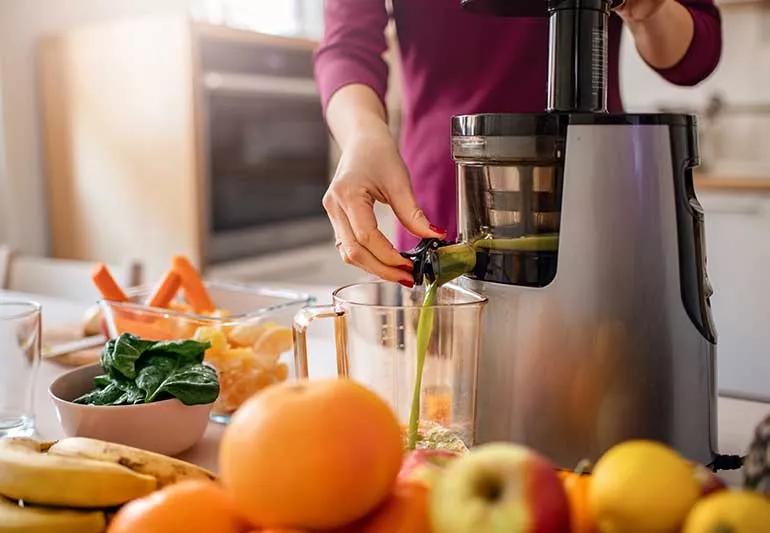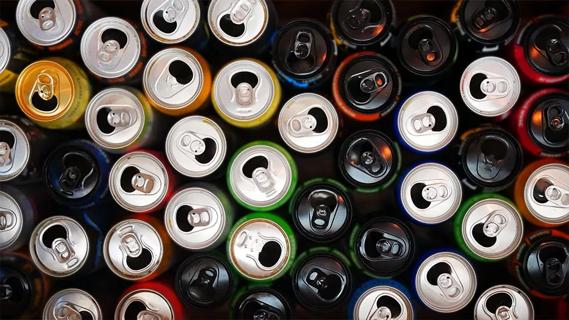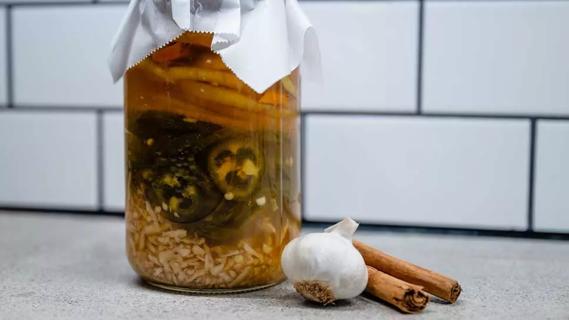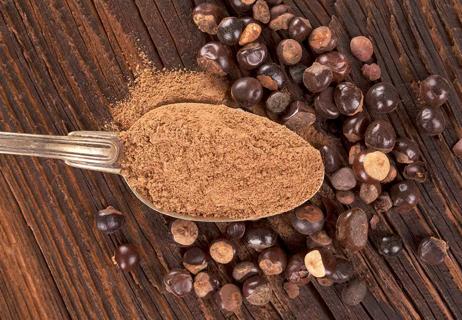Juicing removes beneficial fiber from fruits and veggies and raises your blood sugar

You know fruits and vegetables are packed with vitamins and minerals that fuel your body. So, when you choose a bottled juice from the store or make your own at home (look at you, fancy!) you might be tempted to give yourself a pat on the back.
Advertisement
Cleveland Clinic is a non-profit academic medical center. Advertising on our site helps support our mission. We do not endorse non-Cleveland Clinic products or services. Policy
You’ve upped your nutritional game! Soaking up your vitamins and minerals with every sip!
Unfortunately, the celebration isn’t quite merited.
Yes, juicing can up your intake of certain nutrients. And that’s something you can feel good about. But when you squeeze juice from produce, you leave behind some important stuff, too. And your sugar intake? Sky high.
We talked with registered dietitian Natalie Romito, RD, LD, about what you’re getting (and missing) when you’re juicing.
Turning fruits and vegetables into drinks isn’t a new idea. Some reports say people have been making and consuming juice for hundreds, if not thousands, of years.
But it wasn’t until the 1990s that juice bars and home juicers started becoming more and more mainstream. Ill-advised juice cleanses started sprouting up. And around that same time, smoothies started taking off, too.
And while both smoothies and juices remain popular today, nutritionally, there’s a difference.
Smoothies are made in blenders, which break food down to the point where you can drink it through a straw. Juicers, on the other hand, extract liquid from fruits and vegetables.
“When you make a smoothie, whatever goes into the blender comes out in your drink,” Romito explains. “But with juicing, the pulp gets removed.”
Advertisement
And the pulp matters. Because what you wind up throwing away or composting contains important nutrients that your body could use.
Juice is, by some measures, a healthy choice in moderation. But it’s not the best choice you could make.
“It’s a question of healthier than what?” Romito points out. “Juice is going to be a healthier choice than drinking, say, a soda. But it’s not as healthy as eating fruits and veggies in their natural form.”
Romito explains why that is.
Typically, what you get when juicing fruits and vegetables is a good amount of the food’s vitamins, minerals, antioxidants, polyphenols and other compounds that your body loves. Not all of them, but some at least. More on that in a bit.
So, depending on what foods you put in the juicer, you can increase your intake of things like vitamin C, vitamin K, folic acid, magnesium and other good-for-you stuff.
“If the food’s color is translating into your juice, you can feel good that you’re getting some of the antioxidants and vitamins that your fruits and vegetables have naturally,” Romito notes.
Some people will tell you, too, that drinking juice, rather than eating whole fruits and veggies, allows your body to better absorb those nutrients. That may be true of some foods, Romito acknowledges. When you break down the cell walls of certain plant-based foods — either from things like juicing or cooking them — you can absorb some nutrients a little better.
But Romito says the potential benefit of better absorption doesn’t outweigh what you’re losing out on when you juice.
Even though your juice may be high in vitamin content, that’s not the full story.
Romito explains the downsides of juicing.
Remember the pulpy leftovers that juicers make? It’s full of fiber. And fiber makes a big difference in the health content of your foods and drinks.
Some of your food’s polyphenols and antioxidants are wrapped up in that fiber. So, when you remove the fiber, you lose out on some of those nutrients.
Also, fiber is important for making you feel full. And it helps with digestion, lowering cholesterol and stabilizing your blood sugar.
“Fiber is important for our bodies in a lot of ways. But when you’re juicing, you remove fiber from the food. That changes the way the natural sugars in that food work in your body. So, something like apple juice is much more likely to have a big effect on your blood sugar than eating a whole apple would,” Romito explains.
Here’s why.
In their natural form, fruits are chock full of natural sugars. And for most people, natural sugars from whole foods don’t cause spikes in your blood sugar in the way that refined sugars do.
Advertisement
That’s because the sugar in fruit is all wrapped up in fiber. Your body doesn’t digest fiber, so the majority of those sugars don’t get absorbed in your bloodstream.
Strip out the fiber, though, and the sugar content from the fruit acts more like refined sugar in your body. You get sugar rushes. Sugar crashes. Sugar cravings. And for people with diabetes, the sugar overload can be dangerous.
What’s more, fiber helps your body feel full. When you drink juice, it doesn’t help to fill your belly like eating whole food would. So, you risk overeating.
The average person should aim for three to four servings of fruit and at least three servings of vegetables per day. One serving is typically considered to be:
When you juice fruits and vegetables, you can easily wind up taking in a whole lot more.
Consider this: 12 ounces of apple juice or cider has about the same calories and sugar as eating three small apples. But the juice has virtually no fiber. So, your body will absorb the sugar from those apples much more quickly. The result? You’ll be hungrier faster than if you ate the apples themselves.
Advertisement
“Juicing makes it a lot easier to overconsume,” Romito says. “Most people will naturally moderate their fruit intake when they eat whole foods because they get tired of chewing it and the fruit’s fiber fills them up.”
Most people probably aren’t going to eat three or four apples in a row, too. Or munch their way through a whole bag of carrots in one sitting. Your jaw would be begging for a break by then. But it’s really easy to drink the equivalent amount — and more — in juice. And still be hungry after.
“You wind up taking in more sugars and more calories when you’re having a juice form versus when you’re having the whole food form,” Romito emphasizes. “When you don’t have to chew food, you’re bypassing your body’s natural mechanisms that help regulate your eating.”
If you want to include some juice here and there, that’s probably OK for most people. Just know that it shouldn’t be your primary method for including fruits and veggies in your diet.
Romito offers these tips for healthier juicing:
Advertisement
Fruits and vegetables that are as close to their natural form as possible are always going to be the healthier choice. And while sipping on some juice can be a yummy way to get in some vitamins and minerals, just remember that it shouldn’t be your primary source of fruits and veggies in your diet.
Learn more about our editorial process.
Advertisement

Options for sober social drinking are abundant, but be mindful about additives and triggers

Pickle juice has a reputation as a probiotic powerhouse, workout recovery aid, hangover cure and more

If you’re looking to boost your gut health, it’s better to get fiber from whole foods

While it isn’t bad for you, celery juice isn’t the detox phenom it’s claimed to be

Regularly drinking these sugar-fueled, stimulant-laden beverages can increase your risk of adverse health effects

This spicy concoction can do more harm than good, upsetting your stomach and causing painful acid reflux

Sports drinks can give your body a boost, but it’s important not to overuse them

Guarana seeds may have benefits, but the potential is lost in processing

The ‘sunshine vitamin’ is found naturally in some fish and is added to other foods

Autism and ADHD often go hand in hand, giving rise to the term AuDHD

The Yuzpe regimen is less effective than other forms of emergency contraceptives, and it’s associated with more side effects